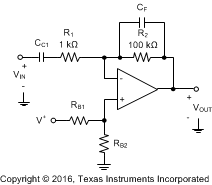SNOSAQ5H February 2007 – August 2016 LMV551 , LMV552 , LMV554
PRODUCTION DATA.
- 1 Features
- 2 Applications
- 3 Description
- 4 Revision History
- 5 Pin Configuration and Functions
- 6 Specifications
- 7 Detailed Description
- 8 Application and Implementation
- 9 Power Supply Recommendations
- 10Layout
- 11Device and Documentation Support
- 12Mechanical, Packaging, and Orderable Information
Package Options
Mechanical Data (Package|Pins)
- DGK|8
Thermal pad, mechanical data (Package|Pins)
Orderable Information
1 Features
- Specified 3-V and 5-V Performance
- High Unity Gain Bandwidth 3 MHz
- Supply Current (Per Amplifier) 37 µA
- CMRR 93 dB
- PSRR 90 dB
- Slew Rate 1 V/µs
- Output Swing With 100-kΩ Load 70 mV From Rail
- Total Harmonic Distortion: 0.003% at 1 kHz, 2 kΩ
- Temperature Range: −40°C to 125°C
2 Applications
- Active Filters
- Portable Equipment
- Automotive
- Battery Powered Systems
- Sensors and Instrumentation
3 Description
The LMV55x are high-performance, low-power operational amplifiers implemented with TI’s advanced VIP50 process. They feature 3 MHz of bandwidth while consuming only 37 µA of current per amplifier, which is an exceptional bandwidth to power ratio in this op amp class. These ultra-low power amplifiers are unity gain stable and provide an excellent solution for ultra-low power applications requiring a wide bandwidth.
The LMV55x have a rail-to-rail output stage and an input common mode range that extends below ground.
The LMV55x have an operating supply voltage range from 2.7 V to 5.5 V. These amplifiers can operate over a wide temperature range (−40°C to 125°C), making them a great choice for automotive applications, sensor applications as well as portable instrumentation applications. The LMV551 is offered in the ultra tiny 5-Pin SC70 and 5-Pin SOT-23 package. The LMV552 is offered in an 8-Pin VSSOP package. The LMV554 is offered in the 14-Pin TSSOP.
Device Information(1)
| PART NUMBER | PACKAGE | BODY SIZE (NOM) |
|---|---|---|
| LM551 | SOT-23 (5) | 2.90 mm × 1.60 mm |
| SC70 (5) | 2.00 mm × 1.25 mm | |
| LMV552 | VSSOP (8) | 3.00 mm × 3.00 mm |
| LMV554 | TSSOP (14) | 5.00 mm × 4.40 mm |
- For all available packages, see the orderable addendum at the end of the data sheet.
Typical Application Schematic

Open Loop Gain and Phase vs Frequency
